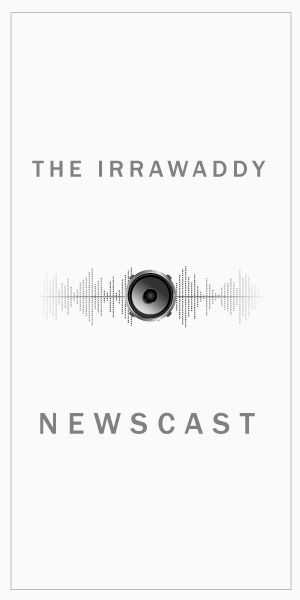As a young boy, Ko Yan Naung Oak wanted to be a scientist—he was interested in technology and his favorite subject was physics. He spent his childhood in Singapore and majored in economics in the US. “I was never able to choose one thing that I wanted to do,” he said.
Now the 30-year-old is a senior adviser at Phandeeyar, an information technology innovation hub in downtown Yangon. His work mainly involves assisting civil society organizations, journalists, entrepreneurs and others to do their work better by using technology. He was among the first to introduce data journalism to Myanmar journalists covering the 2015 general election and continues to train local media representatives.
“What I am currently doing is kind of the combination of my interest in technology with my interest in different things combined together,” he told The Irrawaddy recently.
Ko Yan Naung Oak said someone working at a think tank or in academia can do all the research in the world but they cannot bring that to the people’s attention in the same way journalists can. “I think the ability of journalists is to tell a story that really resonates with people and also gives a bigger picture with the data. It is very important for a country like Myanmar,” said he during a recent conversation with The Irrawaddy’s Tin Htet Paing.
What is data journalism?
Data journalism has two sides. One is using data to find a story that is worth telling, so using data as a source to strengthen your story and to start looking for interesting things within the data that you can tell to your audience. The other side is presenting a story using data. So, that would be having nice graphics, visualization, maps and interactive elements—data as a source and data as visual casing for a story.
I think to simplify it even further, it would involve including quantitative elements in traditional storytelling. It’s all about telling a story people relate to. Even if you put in a lot of quantitative analysis, you still have to bring it down to a level where people don’t just look at it and think ‘this is just a bunch of numbers.’ Instead, it expands on something that they can already relate to. You can give an example about an individual person and their story, but putting that in a context of the larger number can give the bigger picture. For example, the individual person you are following in your story may be the tip of the iceberg, but to show everything hidden under the water, you need to show the numbers.
What do you think of the data literacy of Myanmar journalists?
People who became journalists did so because they are interested in reading books and writing, not working with spreadsheets and numbers, so there’s that kind of foundation that you are working with. But at the same time, I think in Myanmar, in the past especially, people have learned to not trust official statistics and to not believe any official numbers that come out. That, I think, adds to the feeling that [people have]: this phobia of numbers. If something is in numbers, it’s completely meaningless and anyone could have made that up. So you don’t have trust in the numbers. You don’t feel like you should invest any effort trying to understand what the numbers are all about.

Myanmar has very little data online. How can journalists gather data?
One, the government data landscape is changing. There are individual departments that are forthcoming with sharing data. For example, if you go to the YCDC [Yangon City Development Committee] website, there’s a lot more data than most other government departments. If you go to the DICA [Directorate of Investment and Company Administration] website, you can get a lot of data on company registrations, and that database is definitely more complete than even our neighboring countries. But apart from government sources, there are also a lot of other organizations that are either producing data, doing country-wide surveys or collecting and taking datasets from global databases and just curating it for Myanmar. The organization that I work for, Open Development Myanmar, which is part of Phandeeyar, is one those organizations that takes data from various sources and puts it online in easily accessible forms.
The Myanmar Information Management Unit [MIMU] is another one. Several others, such as the Open Myanmar Initiative, work with data from Parliament. There’s the Enlightened Myanmar Research Foundation which also works with political data. So there are a lot of different sources for data.
But also, I was talking about places: data coming from places that you don’t expect. For example, private sector sources. You want to work on a story about housing in Yangon. There are so many websites now that are designed as places where people can post housing classified advertisements. Journalists working together with someone who knows technological tools to scrape data and get data from websites like that have a treasure trove of data that they can work with to dig into a lot of different stories. I see my role as being the bridge between people who have the skills and journalists to find that data and also being the bridge between civil society groups who have a lot of things that they are passionate about—they might have data that they have collected but not in a usable format, like written down in a book—and make that data accessible for journalists to be able to use it.
What about the “dataphobic” readers? Are they ready to be convinced by stories told through data?
That’s a harder question for sure. I will use an example friends have told me about trying data journalism in other countries. I think this is a story about healthcare in Kenya. Journalists wanted to tell a data-driven story about how there is a problem throughout the country in the healthcare system. They used one person’s story to show this problem in a way that people could follow and they specifically said the problem is not just this one person. But what ended up happening is that the story went viral and people really related to it and then they started sending donations to that one guy when the journalists specifically said this was just one example of a big problem and what you need to do is to change the system. But people still relate to the most to personal stories, and that happens all over the world I think.
There are a lot of problems with just using data to convey something to an audience that is not used to thinking with data, and there is a lot of inherent bias that people have. If you see something that is connotatively stated that confirms your bias and you are more likely to trust it. If you see something that someone said, proved with data but goes against what you believe in, you are likely to disregard it. You see that everywhere as well. And I think in Myanmar, that’s going to be even more pronounced. I think one of the jobs or tasks that journalists have to deal with is making the data relatable but not simplifying it so much that people lose the point of it.
Can data be easily manipulated to mislead?
There are so many ways to mislead and misguide people. You can definitely see it in newsrooms that have inherent bias and agendas that they want to push. When people see numbers, like we said before, if they don’t trust the source, no matter how good the numbers are, they will disregard it. But if someone who they already trust gives them something in kind of a neat and well-presented way with numbers, they will believe it even more just because the numbers are there. That just causes people’s beliefs to be more polarized, I think.
What are the challenges you face training journalists?
One of the main difficulties is that a lot of newsrooms in Myanmar are tightly staffed. So journalists really don’t have a lot of time to devote to learning. Even a five-day workshop is really a challenge. I understand that they are having to deal with a really big workload, but at the same time, I think it would be great if we have buy-in from the editors and the business side of things and also the journalists themselves that it will be a good thing to devote some time to really learn how to do these sorts of things. I think there’s a lot of work to be done in order to get that buy-in. What I am hoping for is some journalists will see the value that they can add, not just to their professional skills but also to their newspapers as a business and something that creates an impact on the country.

















